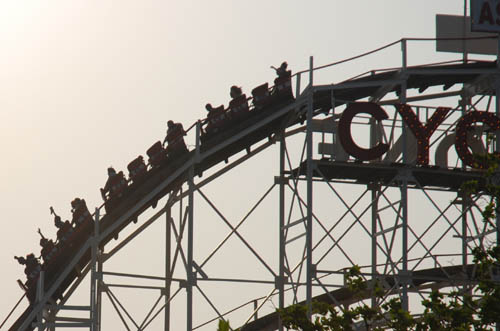Coney Island #1: The View of the Strategic Planners

The Gotham Gazette offers two interesting pieces about Coney Island redevelopment this week. One of them is from Coney Island Development Corp. President Lynn Kelly and is based on her remarks at a Municipal Art Society discussion last week. It's an interesting window into her thinking. Here are some excerpts, but we suggest a read in its entirety if you're interested in Coney Island development:
History will show that in Coney Island, the city made mistakes. Now we have a great opportunity, with everyone united, to change that.The zoning sought by developer Joe Sitt and Thor Equities differs in some significant ways from the larger amusement zone envisioned by the Strategic Plan.
The first step took place in the previous administration with the implementation and building of Keyspan Park for baseball’s minor league Brooklyn Cyclones in 2001. When the Bloomberg administration came in in January of the following year, the first step was to unite the local elected leaders and come up with a vision of how we were to change Coney Island. The Coney Island Development Corporation was formed in 2004 by the mayor, Brooklyn Borough President Marty Markowitz and the local city council member, Dominic Recchia. It has a 13-member board and is charged with spearheading a comprehensive economic development strategy for Coney Island.
As the president of the Coney Island Development Corporation, one of my first tasks was to work on the strategic plan. The vision for Coney Island, released in 2005, was based on three strategies. - It is important to get year round activity, new entertainment, and retail. - It is important to enhance the amusement district, because, without enhancing the amusement district, we’ve effectively lost Coney Island, we’ve lost that brand. - And lastly, Coney Island is in the middle of a vibrant neighborhood of over 50,000 residents, and it is important to provide opportunities to those residents.
How will we achieve this? The strategic plan breaks Coney Island into different districts, and in each of these districts we have certain goals that will become a part of the reassignment for Coney Island.
In order to look forward, you have to know your past. Let’s start with the historic aspects of Coney Island and the icons that are there: The Wonder Wheel, the Cyclone the Parachute Jump, the Aquarium, the Shore Theater. All of these are going to anchors for new development in Coney Island. Four of them are landmarks. One – the Parachute Jump -- received a 1.5 million dollar lighting scheme within the past year and went into restoration. This is Coney Island east, the main amusement area, and we really want to see that grow as an amusement park.
We’re proposing new streets because, back in the day, part of the Coney Island experience was the pedestrian experience. You could wander or walk in and around a certain avenue and really enjoy yourself in a way that was pedestrian friendly. Currently the blocks are very large, they’re mega-blocks. One approach to the strategic plan is to break off some us those mega-blocks with new streets.
The existing zoning right now is called C, a very limited zone. It only permits, for the most part, open amusements. We need to give people different experiences when they come to Coney Island -- for example, hotels, music venues, entertainment retail -- and of course, more amusements and rides. So the new zoning would allow activities that could complement an amusement district such as entertainment retail and hotel.
Some might ask, “If you’re going to bring in all this retail and activity, who is going to use it?” A huge part of the strategic plan is residential as well. North of Surf Avenue, where there are currently a lot of vacant parcels with a mixture of public and private ownership, we are proposing residential, with ground floor entertainment retail. You need a reason to walk down Stillwell or Surf Avenue, you need something compelling, and retail is an important part of that plan.
The western end of Coney Island is a transition area and heavily residential. Here again you can ground floor retail. These are parts of the plan that we feel create the critical mass of people within Coney Island...
We’re here, we’re active in Coney Island, we’re anxious to hear your. But let me leave you with one thing: Tell every person you know that this is absolutely not the last summer for Coney Island.
Labels: coney island, Urban Planning

0 Comments:
Post a Comment
<< Home